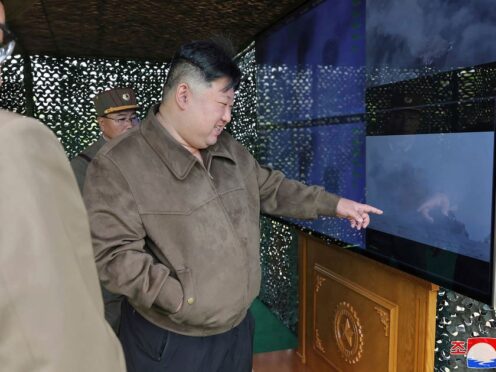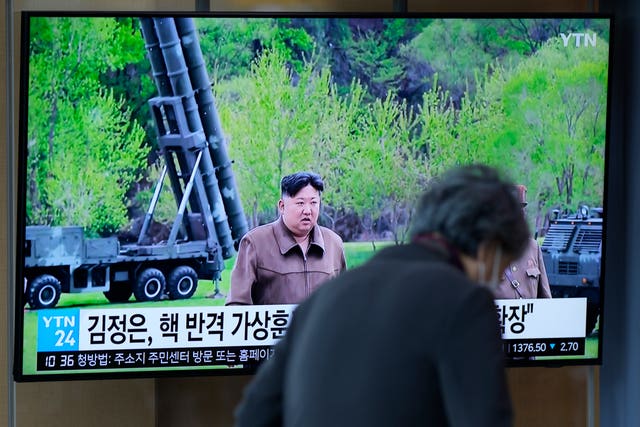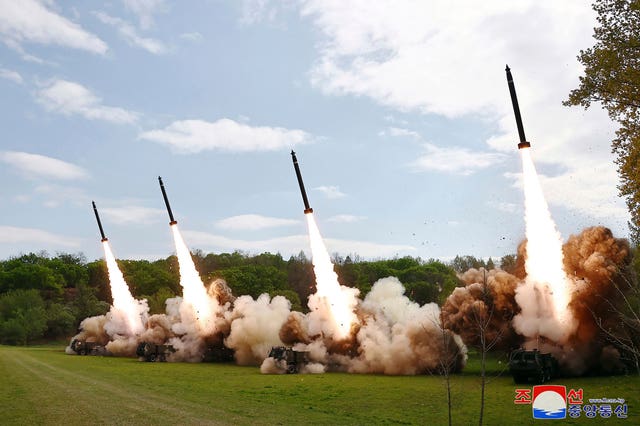
North Korean leader Kim Jong Un supervised launches of the country’s “super-large” multiple rocket launchers that simulated a nuclear counterattack against enemy targets, state media said on Tuesday.
It adds to tests and threats that have raised tensions in the region.
The report by North Korea’s official Korean Central News Agency (KCNA) came a day after the South Korean and Japanese militaries detected the North firing what they suspected were multiple short-range ballistic missiles from a region near its capital, Pyongyang, towards its eastern seas.
Analysts say North Korea’s large-sized artillery rockets blur the boundary between artillery systems and ballistic missiles because they can create their own thrust and are guided during delivery.
The North has described some of these systems, including the 600mm multiple rocket launchers that were tested on Monday, as capable of delivering tactical nuclear warheads.

KCNA said Monday’s launches represented the first demonstration of the country’s nuclear-weapons management and control system called Haekbangashoe, or nuclear trigger.
The report described the drill as aimed at demonstrating the strength and diverse attack means of North Korea’s nuclear forces amid deepening tensions with the United States and South Korea, which it portrayed as “warmongers” raising tensions in the region with their combined military exercises.
State media photos showed at least four rockets being fired from launch vehicles as Mr Kim watched from an observation post.
It said the rockets flew 218 miles before accurately hitting an island target and that the drill verified the reliability of the “system of command, management, control and operation of the whole nuclear force”.
KCNA said Mr Kim expressed satisfaction, saying that the multiple rocket launchers were as accurate as a “sniper’s rifle”.
He said the drill was crucial for “preparing our nuclear force to be able to rapidly and correctly carry out their important mission of deterring a war and taking the initiative in a war in any time and any sudden situation”.
The comments reflected North Korea’s escalatory nuclear doctrine, which authorises the military to launch pre-emptive nuclear strikes against enemies if it perceives the leadership as under threat.

South Korea’s joint chiefs of staff said the weapons from Monday’s launches flew about 185 miles before crashing in the waters between the Korean Peninsula and Japan.
The ranges suggested the weapons would likely target sites in South Korea. The latest launches came as South Korea and the United States have been conducting a two-week combined aerial exercise that continues through Friday aimed at sharpening their response capabilities against North Korean threats.
When asked about the North Korean claims, Lee Sung Joon, spokesperson of South Korea’s joint chiefs of staff, said it remains unclear whether the North perfected the designs for small, battlefield nuclear weapons that could fit on its rockets.
He insisted the North was likely exaggerating the accuracy of its multiple rocket launcher systems and that South Korea would be able to detect and intercept such weapons, without elaborating on specific missile defence capabilities.
In response to North Korea’s evolving nuclear threats, the United States and South Korea have been strengthening their bilateral military drills and trilateral exercises with Japan. The countries are also sharpening their nuclear deterrence strategies built around strategic US assets.

Enjoy the convenience of having The Sunday Post delivered as a digital ePaper straight to your smartphone, tablet or computer.
Subscribe for only £5.49 a month and enjoy all the benefits of the printed paper as a digital replica.
Subscribe